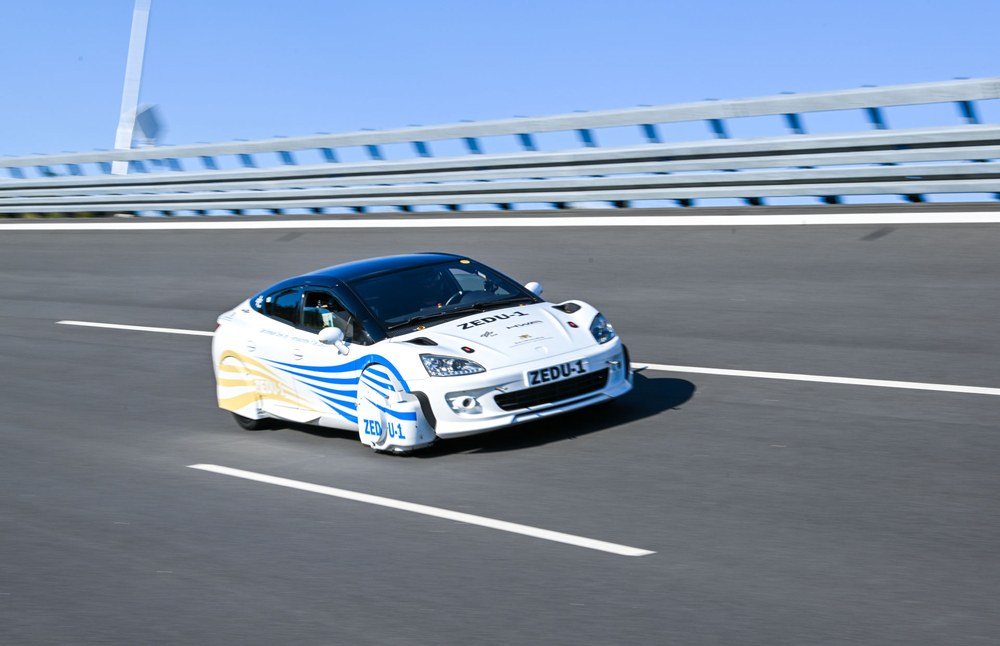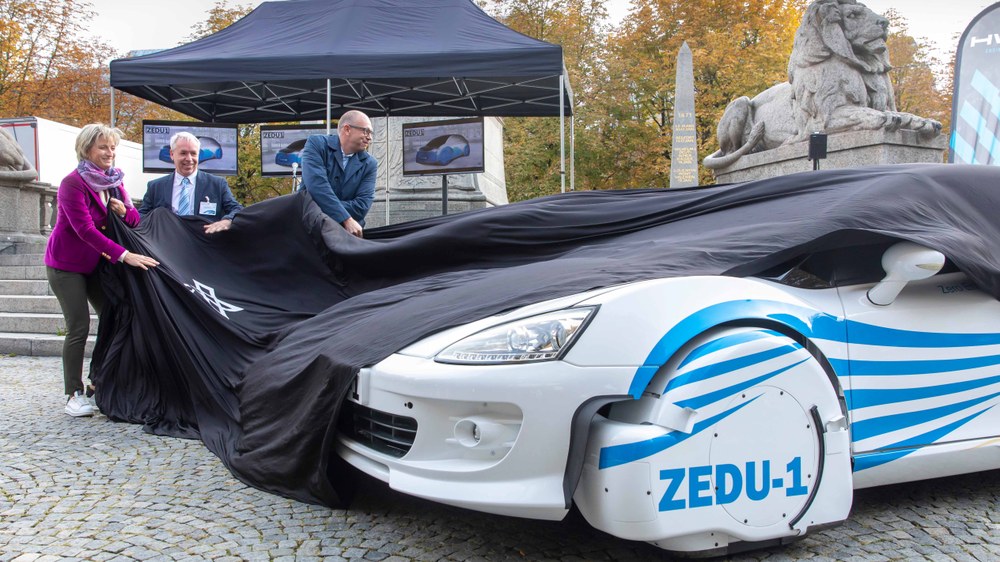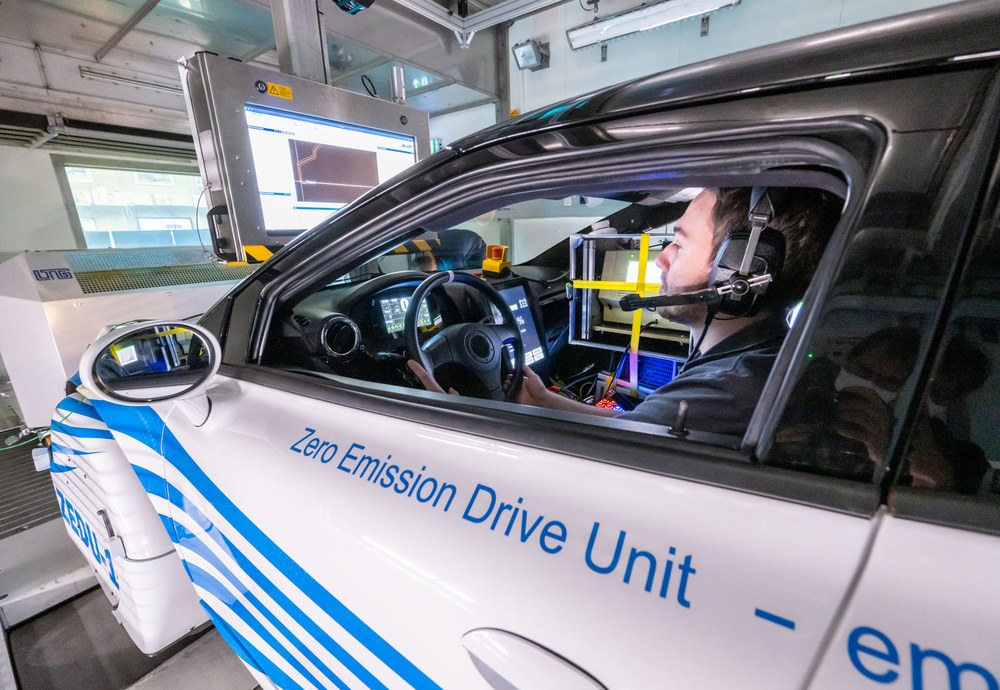ZEDU-1 – The world's most environment-friendly vehicle in operation



- With the ZEDU-1 prototype, DLR and the automotive company HWA have developed a vehicle that is almost completely emission-free in operation.
- The electric car also largely avoids the emission of fine dust and microplastics. These are produced by the abrasion of brakes and tyres.
- This makes ZEDU-1 the most environmentally friendly road vehicle in the world.
- The prototype was presented for the first time in Stuttgart on 28 September 2022.
- Focus: Transport, mobility of the future, alternative drives
As part of its Zero Emission Drive Unit – Generation 1 (ZEDU-1) project – the German Aerospace Center (Deutsches Zentrum für Luft- und Raumfahrt; DLR) and the engineering company HWA have developed and successfully tested a road vehicle that enables mobility almost entirely without emissions. The electric car largely reduces the emission of particulate matter and microplastics caused by the abrasion of tyres and brakes. This makes it the most environmentally friendly road vehicle in operation worldwide. DLR and HWA presented the prototype to the public for the first time on 28 September 2022 in Stuttgart. The Baden-Württemberg Ministry of Economic Affairs, Labour and Tourism has invested six million euros in the project.
"Our priority is human health and an environment without pollution. The ZEDU-1 project focuses on components that have received rather little attention so far and whose emissions are now gradually being regulated by the EU Commission through legislative measures – specifically tyres and brakes. With the ZEDU-1 prototype presented today, we are demonstrating solutions that will enable us to be as close to zero-emission on the road as possible in the future. Our concept is highly efficient, extremely compact, suitable for everyday use and versatile. It can be directly transferred to future passenger cars and commercial vehicles," says Tjark Siefkes, Director of the DLR Institute of Vehicle Concepts in Stuttgart during the presentation of the prototype.
"I am pleased that the research project 'Zero Emission Drive Unit - Generation 1' has successfully developed a prototype that addresses particulate emissions as the most important causes of mobility-related environmental pollution and thus lays the foundation for near zero emission mobility on the road in the future. The results of the research project, funded with six million euro, now provide us with a first-class template for our industry to transfer the technologies to a standard version and to further significantly reduce the abrasion of future vehicles," explains Baden-Württemberg's Minister of Economic Affairs, Labour and Tourism Nicole Hoffmeister-Kraut.
New brake system results in less particulates
In terms of technology, the project team has broken completely new ground. The classic disc brake in the wheel no longer exists. Instead, the brake is removed from the wheel and integrated into the closed electric motor gearbox unit using the innovative approach of a multi-disc brake. In combination with specifically developed high-performance electronics, it is possible to recover the braking energy almost entirely – meaning it can be recuperated. This makes it possible to reduce the size of the brake components to a minimum and to build the drive unit in a very compact way. The discs are submerged in an oil bath. The abrasion then ends up in the oil, which is continuously pumped through a filter and cleaned. In addition to the mechanical multi-disc brake, the team developed an induction brake for the ZEDU-1 prototype. This induction brake results in almost no abrasion until it comes to a standstill and uses magnetic fields to create a braking effect.
Almost magical – wheel arch redesigned to remove microplastics
Removing the brakes from the wheel and integrating them into the drivetrain creates the space for new technological approaches to significantly reduce tyre wear. The basis for this is the housing of the wheels. The closed wheel of the ZEDU-1 is aerodynamically designed to create negative pressure when driving. The tyre abrasion thus accumulates at a specific point. A fan unit in the front of the vehicle extracts the particles there and sends them through a filter system - similar to a hoover. In this way, only purified air exits the vehicle.
Rolling road and test track – ZEDU-1 prototype passes field test
"ZEDU-1 is truly a prototype. In this vehicle, all components are newly developed, including the drive in the form of an electric motor braking unit as well as the housing of the tyres and the aerodynamically adapted components on the vehicle," summarises project manager Franz Philipps from the DLR Institute of Vehicle Concepts. "There are only two ways to test this: in special facilities such as DLR's all-wheel roller dynamometer in Stuttgart and on test sites."
In the summer of 2022, the researchers investigated how well the new components of the ZEDU-1 prototype could reduce emissions of particulates and microplastics under real conditions at the Boxberg test centre and on the institute's own rolling road. For these tests, they worked together with colleagues from the DLR Institute of Combustion Technology. The institute is also based in Stuttgart and uses a state-of-the-art measurement technology and a mobile measurement vehicle. The vehicle can detect and characterise particulate matter down to the ultrafine range. The analyses focused on the total amount of particulate emissions and the size distribution of particles. "To do this, we followed different driving profiles and cycles. This also included the WLTC which stands for 'Worldwide harmonised Light vehicles Test Cycles', a test developed by international experts to determine emissions. In addition, we also carried out special braking manoeuvres and measured emissions in the process," explains Philipps.
Excellent results – zero brake abrasion, significantly less tyre wear even at high speeds
The results of the first test drives have convinced the ZEDU team: "We can confirm that we can completely avoid brake abrasion. As for tyre wear, our measurements have shown that we can completely avoid it up to a speed of 50 kilometres per hour and reduce it by 70 to 80 percent at higher speeds. The next step will be to further develop the technology together with industry in order to successfully start series production."
The public will be able to view the ZEDU-1 prototype in person at the ADAC GT Masters finale in Hockenheim from 21-23 October 2022.
Background – Particulates and microplastics
When it rains, these tiny particles make their way into the drainage system and thus into the water cycle. In Germany alone, this amounts to approximately 110,000 tonnes of matter a year. Braking also causes the abrasion of brake discs and brake pads. Over 90 percent of the resulting debris takes the form of ultrafine particles. These particles are considered to be particularly harmful to the environment and human health, as they can penetrate deep into our respiratory systems and become lodged there before entering the bloodstream. Transport-related abrasion thus contributes to poor air quality in cities as well as the health risk associated with road transport.
